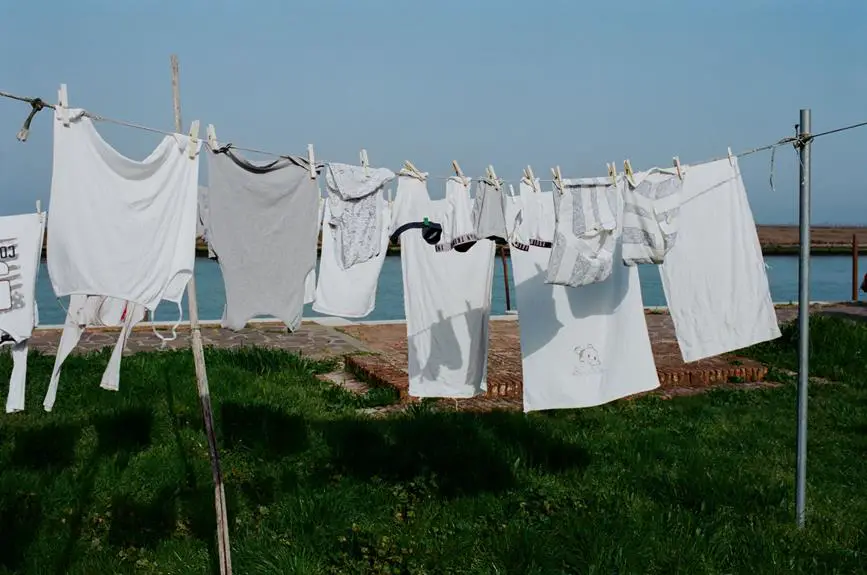Are you seeking to step up your fabric care game with a simple solution?
Homemade starch may be the missing ingredient in your routine. This natural alternative can help you achieve crisp, wrinkle-free fabrics without the harsh chemicals often found in commercial products.
By creating your own starch, you have the power to tailor it to your specific needs and preferences. From cotton to linen, homemade starch can be used on various fabrics to give them a fresh, polished look.
In this guide, we will explore the benefits, how-tos, and tips for using homemade starch, as well as compare it to its commercial counterparts.
Get ready to elevate your fabric care routine with the wonders of homemade starch.
Key Takeaways
- Homemade starch achieves smoother and crisper fabrics.
- Homemade starch provides an eco-friendly alternative to commercial starches.
- Homemade starch allows control over ingredients for tailored fabric care.
- Homemade starch is a cost-effective solution compared to store-bought options.
The Benefits of Homemade Starch
You can achieve smoother and crisper fabrics by using homemade starch. When it comes to fabric care, homemade starch offers numerous benefits. Not only does it help to achieve that perfectly pressed look, but it also provides an eco-friendly alternative to commercial fabric starches.
One of the main advantages of using homemade starch is that you have control over the ingredients, allowing you to create a solution that's tailored to your specific fabric care needs. This means you can avoid harsh chemicals and opt for more natural and environmentally friendly options.
Homemade starch also offers the benefit of being cost-effective. With just a few simple ingredients like cornstarch and water, you can create a starch solution that can be used on various fabric types. This not only saves you money but also reduces the environmental impact of using commercial fabric care products.
In addition to providing a smoother finish, homemade starch can also help to extend the life of your clothing by reducing the need for excessive washing and ironing. This isn't only beneficial for your fabrics but also aligns with a more sustainable and eco-friendly approach to fabric care.
How to Make Homemade Starch
To make homemade starch, start by mixing one tablespoon of cornstarch with one cup of cold water until smooth. This creates a basic starch solution. The starch consistency can be adjusted based on personal preference. For a lighter starch, use less cornstarch, and for a heavier starch, use more cornstarch in the mixture.
Experiment with different ingredient variations to customize the starch to suit your fabric care needs. Some people prefer adding a few drops of essential oils for a pleasant fragrance, while others may opt for adding a small amount of vinegar to help soften the fabric.
Once you have your desired starch consistency and ingredient variations, transfer the mixture to a spray bottle for easy application. Remember to shake the bottle well before each use to ensure the starch is evenly distributed.
Making homemade starch allows you to tailor the product to your specific fabric care requirements, providing a cost-effective and customizable alternative to store-bought options.
Using Homemade Starch on Different Fabrics
When using homemade starch on different fabrics, it's important to test a small, inconspicuous area first to ensure compatibility and desired results.
Here are some tips to help you achieve the best outcomes when using homemade starch on different fabric types:
- Cotton and Linen: These fabrics generally respond well to homemade starch application. However, be cautious with dark-colored items as the starch may leave a white residue.
- Synthetics: Fabrics like polyester and nylon may not require starching as they're designed to maintain their shape and crispness without it. If you do choose to starch, use a lighter application to avoid stiffness.
- Delicates: Fabrics like silk and wool should be starched with care. Use a very light spray or application to prevent damage to the delicate fibers.
- Blends: Fabrics that are a combination of different materials, such as cotton-polyester blends, may require a more moderate approach to starching. Test a small area first to gauge the fabric's reaction.
Understanding the best approach to starching different fabric types will help you achieve the desired results while maintaining the integrity of your garments.
Tips for Applying Homemade Starch
When it comes to applying homemade starch, there are a few key techniques to keep in mind. These techniques can help you achieve the desired level of stiffness and crispness in your fabrics.
Additionally, understanding how homemade starch can assist in stain removal and fabric preservation is essential for maximizing its benefits.
Starch Application Techniques
After you have prepared your homemade starch, it's important to apply it to your fabric using the proper techniques to achieve the best results. Here are some tips for applying homemade starch:
- Even Distribution: Ensure that the starch is evenly distributed on the fabric to avoid any patchiness.
- Proper Drying: After applying the starch, allow the fabric to properly dry to achieve the desired level of stiffness.
- Ironing Technique: When ironing the fabric, use a steady motion and moderate pressure to set the starch into the fibers.
- Testing on a Small Area: Before applying the starch to the entire fabric, test it on a small, inconspicuous area to ensure it achieves the desired effect without causing any damage.
Stain Removal Benefits
To achieve effective stain removal benefits when applying homemade starch to your fabric, follow these simple yet impactful tips. When dealing with stubborn stains, homemade starch can be a game-changer in your laundry routine. Here are some stain removal techniques that can be enhanced by using homemade starch:
| Stain Type | Homemade Starch Application | Additional Steps |
|---|---|---|
| Grease | Apply starch directly to the stain, let it sit for 10 minutes, then wash as usual | Use a brush to gently scrub the stained area before washing |
| Wine | Blot the stain, apply starch, let it sit for 5 minutes, then wash as usual | Soak the fabric in cold water before applying starch |
| Blood | Mix starch with cold water to form a paste, apply to the stain, let it sit for 15 minutes, then wash as usual | Use cold water to prevent the blood from setting |
Fabric Preservation Methods
To ensure the longevity and quality of your fabrics, enhance your fabric care routine by utilizing homemade starch with simple and effective preservation methods. When applying homemade starch for fabric preservation, consider these tips for optimal results:
- Proper Application: Ensure even distribution of the homemade starch on the fabric to maintain its structure and texture.
- Sun Drying: After applying the homemade starch, sun drying the fabric can help set the starch and preserve the fabric's crispness.
- Ironing Technique: Use a medium heat setting while ironing the fabric to activate the starch and achieve a smooth, preserved finish.
- Storage: Store starched fabrics in a cool, dry place to prevent moisture build-up and maintain the fabric's integrity.
Homemade Starch Vs. Commercial Starch Products
When it comes to homemade starch versus commercial starch products, there are a few key points to consider.
Firstly, homemade starch can be a cost-effective option, saving you money in the long run.
Additionally, there are environmental impact considerations to take into account when choosing between the two.
Cost-Effective Starch Options
Using homemade starch as a cost-effective alternative to commercial starch products can provide excellent results for your fabric care routine.
Homemade starch offers a cost-effective solution compared to purchasing commercial starch products. Here are four reasons why homemade starch can be a cost-effective choice for your fabric care routine:
- Affordability: Homemade starch is made from natural ingredients that are readily available, making it a more affordable option compared to commercial starch products.
- Customizability: With homemade starch, you have the flexibility to adjust the concentration to suit your specific fabric care needs, allowing you to use it more efficiently.
- Reduced Chemical Exposure: By using homemade starch, you can minimize exposure to potentially harmful chemicals found in some commercial starch products, contributing to long-term cost savings on health-related issues.
- Sustainability: Making your own starch supports sustainability by reducing the need for purchasing single-use plastic bottles and packaging, aligning with a cost-effective and eco-friendly approach to fabric care.
Environmental Impact Considerations
Consider the environmental impact of homemade starch versus commercial starch products before incorporating them into your fabric care routine.
When it comes to environmental impact, homemade starch offers a more sustainable option compared to commercial starch products. Making starch at home allows you to control the ingredients, reducing the carbon footprint associated with manufacturing and transporting commercial starch products.
Additionally, homemade starch promotes sustainability practices as it eliminates the need for excessive packaging and reduces the use of chemicals that can harm the environment.
Homemade Starch: The Final Verdict
After evaluating the effectiveness of homemade starch, you'll want to know if it's worth incorporating into your fabric care routine. Let's take a closer look at the final verdict.
Here's what you need to consider:
- Effectiveness: Homemade starch may not yield the same results as commercial products, but it can still provide a noticeable improvement in fabric crispness and wrinkle resistance.
- Cost-Efficiency: DIY starch alternatives are incredibly cost-effective. Making your own starch at home can save you money in the long run, especially if you use it frequently.
- Customization: Unlike store-bought starch, homemade starch allows you to customize the strength of the solution to suit your specific fabric care needs.
- Environmental Impact: Using homemade starch aligns with eco-friendly practices. By opting for natural ingredients, you contribute to reducing the environmental impact of fabric care experiments.
Frequently Asked Questions
Can Homemade Starch Cause Any Damage to Fabrics Over Time?
Using homemade starch in your fabric care routine can potentially cause damage over time. The long-term effects may include weakening of fabric fibers and buildup of residue, impacting the quality and lifespan of your textiles.
Are There Any Potential Allergic Reactions to Homemade Starch?
Potential allergens in homemade starch application can lead to skin irritation or respiratory issues. Always test a small area first and consider using alternative starches like cornstarch or arrowroot to minimize potential allergic reactions.
Can Homemade Starch Be Used on Dry Clean Only Fabrics?
When using starch on delicate fabrics, it's important to proceed with caution. Homemade starch may not be suitable for dry clean only fabrics, but there are alternative methods like steaming or using a professional fabric refresher.
How Long Does Homemade Starch Typically Last on Clothing Before Needing Reapplication?
Homemade starch can last on clothing for several wearings before needing reapplication. The longevity of the starch depends on factors like fabric type and wear. Regularly assess and reapply homemade starch to maintain fabric care.
Can Homemade Starch Be Used on Colored or Patterned Fabrics Without Causing Discoloration or Damage?
When using homemade starch on colored or patterned fabrics, ensure it's applied lightly and evenly to prevent discoloration or damage. Reapply as needed, and consider testing a small area first, especially if you have allergies. Dry cleaning can help maintain fabric quality.
- How Does Ring Spun Cotton Affect Garment Fit and Shape Retention? - August 13, 2024
- What Are the Challenges in Producing Ring Spun Cotton? - August 13, 2024
- Is Ring Spun Cotton Suitable for Plus-Size Clothing? - August 13, 2024







